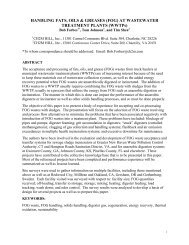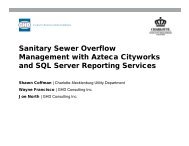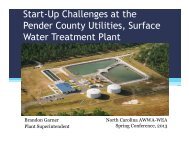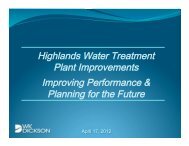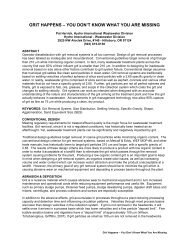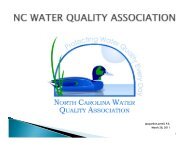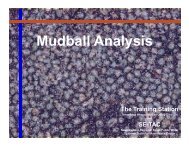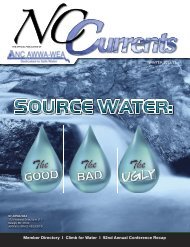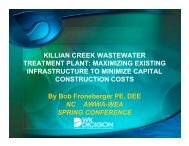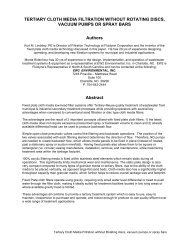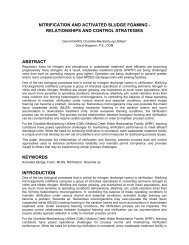Impact of EPA Drinking Water Stage 2 Disinfectant and Disinfectant ...
Impact of EPA Drinking Water Stage 2 Disinfectant and Disinfectant ...
Impact of EPA Drinking Water Stage 2 Disinfectant and Disinfectant ...
Create successful ePaper yourself
Turn your PDF publications into a flip-book with our unique Google optimized e-Paper software.
1<strong>Impact</strong> <strong>of</strong> <strong>EPA</strong> <strong>Drinking</strong> <strong>Water</strong> <strong>Stage</strong> 2<strong>Disinfectant</strong> <strong>and</strong> <strong>Disinfectant</strong> By-ProductRuleNCAWWA-WEA 2013 Spring ConferenceApril 15, 2013Eric JordanRegional Sales ManagerSwan Analytical USADisinfection
2Agenda• Regulations– Safe <strong>Drinking</strong> <strong>Water</strong> Act• Disinfection– Monochloramine• Disinfection By-Products• Measuring <strong>Disinfectant</strong> Concentration• Desirable Analyzer Features• Conclusion• QuestionsDisinfection
3Safe <strong>Drinking</strong> <strong>Water</strong> Act <strong>of</strong> 1974• The Safe <strong>Drinking</strong> <strong>Water</strong> Act (SDWA) is themain federal law that ensures the quality <strong>of</strong>Americans' drinking water.• Under SDWA, <strong>EPA</strong> sets st<strong>and</strong>ards for drinkingwater quality <strong>and</strong> oversees the states, localities,<strong>and</strong> water suppliers who implement thosest<strong>and</strong>ards.• The law was amended in 1986 & 1996 requiringmany actions to protect drinking water <strong>and</strong> itssources: rivers, lakes, reservoirs, springs, <strong>and</strong>ground water wells.Disinfection
Amendments to Safe <strong>Drinking</strong> <strong>Water</strong> Act <strong>of</strong> 19744• Amendments to the SDWA in 1996 require<strong>EPA</strong> to develop rules to balance the risksbetween microbial pathogens <strong>and</strong> disinfectionbyproducts (DBPs).• The <strong>Stage</strong> 1 <strong>Disinfectant</strong>s <strong>and</strong> DisinfectionByproducts Rule <strong>and</strong> Interim Enhanced Surface<strong>Water</strong> Treatment Rule, promulgated inDecember 1998, were the first phase in arulemaking strategy required by Congress aspart <strong>of</strong> the 1996 Amendments to the Safe<strong>Drinking</strong> <strong>Water</strong> Act.Disinfection
<strong>Stage</strong> 2 Rule5• The <strong>Stage</strong> 2 <strong>Disinfectant</strong>s <strong>and</strong> DisinfectionByproducts Rule (<strong>Stage</strong> 2 DBPR) builds upon the<strong>Stage</strong> 1 DBPR to address higher risk public watersystems.• This final rule strengthens public health protectionby tightening compliance monitoring requirementsfor two groups <strong>of</strong> DBPs, trihalomethanes (TTHM)<strong>and</strong> haloacetic acids (HAA5).• <strong>Stage</strong> 2 DBPR requires systems to perform asystem evaluation to identify the locations withhigh DBP’s which become the systemscompliance sampling points.Disinfection
6Why Disinfection?Disinfection
Chemistry <strong>of</strong> Chlorination7• Free chlorine is a powerful oxidant <strong>and</strong> reactsrapidly with organic <strong>and</strong> inorganic matter.• As a result, the strong disinfectant residual itinitially provides may not persist as long asnecessary within the distribution system.• Free chlorine can readily react with organics t<strong>of</strong>orm unwanted disinfection byproducts (DPBs)such as trihalomethanes (THMs) <strong>and</strong> haloaceticacids (HAAs).Disinfection
8Chemistry <strong>of</strong> Chlorination• How does chlorine actually carry out disinfection?• Depending on pH, the reaction <strong>of</strong> HOCl <strong>and</strong> water furtheryields an equilibrium between hypochlorous acid <strong>and</strong>hypochlorite ion.• The further dissociation, along with the two types <strong>of</strong>“hypos”(mainly hypochlorous acid which is electricallyneutral), can penetrate the cell walls <strong>of</strong> the organism <strong>and</strong>displace molecules needed to survive. The organism can nolonger function or replicate <strong>and</strong> eventually dies.Disinfection
9Chemistry <strong>of</strong> Chlorination• Free Chlorine• HOCl is approx. 70-90 timesstronger oxidant then theHypochlorite ion “OCl-”which is predominant inhigher pHs.• Efficiency <strong>of</strong> Disinfectionwith Free Chlorinedecreases significantly withan increase in pH value.Disinfection
10Chemistry <strong>of</strong> Chlorination• Chlorine, an element in the halogen family, isrepresented by the symbol Cl. It has oneunpaired electron in its outer valence shellmaking it highly reactive <strong>and</strong> an oxidizing agent.unpairedelectronDisinfection
11Chemistry <strong>of</strong> Chlorine• Atomic Number 17, 17 positively charged protons in the nucleuswhich are neutralized by the 17 negatively charged electrons in aseries <strong>of</strong> outer shells• These shells, which applies to most every atom in the periodic table,will be full <strong>and</strong> stable at 8 electrons.(Octet Rule)(Noble Gases)• Chlorine is in group 7 in the periodic table which means it has 7electrons in its outer shell which are used in bonding.• If chlorine were to lose these 7 electrons, then the 7 protons in thenucleus would be in excess giving chlorine a valence(oxidation state)<strong>of</strong> +7.• This is not how it works, chlorine by definition(Octet Rule) wants tohave a full outer shell(8e’s) so it takes on one electron to have anoverall valence <strong>of</strong> -1. Thus giving a stable chlorine radical <strong>of</strong> Cl -1• Chemistry is the constant attraction <strong>and</strong> repelling <strong>of</strong> electrons. Theforces that cause bonding are simply just electrons combining withother electrons.Disinfection
Chemistry <strong>of</strong> Chlorination12• Elemental chlorine exists as a two-atom moleculewith the symbol Cl 2 . In this arrangement, eachatom has 8 valence electrons in its outer shell.• The molecular weight <strong>of</strong> thisdiatomic molecule is 70.92.• The bonding between the two atoms is relativelyweak <strong>and</strong> keeps the Cl 2 molecule highly reactive.Disinfection
13Chemistry <strong>of</strong> Chlorination• During hydrolysis, chlorine reacts rapidly withwater to form hypochlorous acid (HOCl) <strong>and</strong>hydrochloric acid (HCl).Cl 2 + H 2 OHOCl + HCl• Of the two compounds, hypochlorous acid ismore important in the water treatment process. Itcontains the active form <strong>of</strong> chlorine that will beused to disinfect organisms.Disinfection
14Chemistry <strong>of</strong> Ammonia• Ammonia (NH 3 )is acompound made up <strong>of</strong>one nitrogen atom <strong>and</strong>three hydrogen atoms.• The nitrogen atom hasan atomic mass <strong>of</strong> 14<strong>and</strong> each hydrogenatom has an atomicmass <strong>of</strong> 1 givingammonia a totalmolecular weight <strong>of</strong> 17.Disinfection
15History <strong>of</strong> Monochloramine Use• In the early 1900’s chloramination receivedattention when it was found that the cost <strong>of</strong>chlorination might be reduced.• The practice <strong>of</strong> monochloramine treatment wasadopted in 1916 in Ottawa, Ont.• The first installation in the United States was in1917 in Denver, Colo. Both locations usedammonia <strong>and</strong> hypochlorite <strong>and</strong> notedimprovements in taste .• Becoming more popular to mitigate unwanteddisinfection by-products (DBPs).Disinfection
Chemistry <strong>of</strong> Chloramines16• Chloramines are less aggressive disinfectantsthat reacts more slowly than chlorine howeverremains longer in the distribution system.• Given more stringent disinfection byproductregulations, chloramination can be an appealingalternative to the use <strong>of</strong> free chlorine as a means<strong>of</strong> limiting DBP formation – particularly THMs.• Additional benefits are fewer taste <strong>and</strong> odorconcerns are reported by consumers <strong>of</strong>chloraminated water.Disinfection
17Chemistry <strong>of</strong> ChloraminesThe Basics:Hydrogen1H 114N 735.4Cl 17NitrogenChlorineDisinfection
18Chemistry <strong>of</strong> Chloramines• Chloramine is a general term that describes threerelated compounds:• Monochloramine, NH 2 Cl• Dichloramine, NHCl 2• Trichloramine, NCl 3• Monochloramine is the preferred chloraminecompound for drinking water disinfection.Disinfection
19Chemistry <strong>of</strong> Chloramines• The molecular structure <strong>of</strong>all three chloraminecompounds resembles thestructure <strong>of</strong> ammonia.• A chlorine atom willreplace one, two, <strong>and</strong>three hydrogen atomsrespectively for theformation <strong>of</strong> mono-, di-,<strong>and</strong> trichloramines.NH 3 + HOCl à NH 2 Cl + H 2 ONH 2 Cl + HOCl à NHCl 2 + H 2 ONHCl 2 + HOCl à NCl 3 + H 2 ODisinfection
20Chemistry <strong>of</strong> Chloramination• The formation <strong>of</strong> di-<strong>and</strong> tri-chloramine isminimized by adding a specific weight ratio <strong>of</strong>chlorine <strong>and</strong> ammonia to water while maintainingthe optimal pH range.• Di-<strong>and</strong> tri-chloramines can contribute anobjectionable taste <strong>and</strong> odor to the treated water.• Monochloramines are effective biocides thatcontribute least to taste <strong>and</strong> odor problems.Disinfection
21Clean<strong>Water</strong>DBP: Free Chlorine TreatmentChlorinationFree ChlorineFew if anyChloraminesFreeChlorineTotalChlorineDBP0.50ppm 0.55ppm 0.05ppmNSC<strong>Water</strong>ChlorinationFree ChlorineChloraminesformingFreeChlorineTotalChlorineDBP0.35ppm 0.55ppm 0.20ppmNSC: Not So CleanIncreasing DBP values will raise alarms<strong>and</strong> the source can be investigated.Disinfection
22DBP: MonochloramineChlorinationAmmonia additionTreated<strong>Water</strong>MainlyFree ChlorineMainly Monochloramine.Some byproducts mightbe formedDistributionFreeChlorineFree ChlorineBefore Ammonia additionMonochloramineTotalChlorineDBP0.05ppm 1.00ppm 1.1ppm 0.05ppmFree ChlorineMonochloramineDisinfection byproductsIncreasing DBP values will raise alarms<strong>and</strong> the source can be investigated.Disinfection
Chloramination Process23• To form the monochloramine compound, theappropriate weight ratio <strong>of</strong> chlorine <strong>and</strong> ammoniamust be determined <strong>and</strong> then properly managed.• Free ammonia entering the distribution systemmust be controlled to reduce the potential fornitrification.• Chloramines are weaker oxidizing agents,therefore a higher disinfectant residual is requiredfor similar results. A chloramine residual <strong>of</strong> 2.0mg/L is comparable to a free chlorine residual <strong>of</strong>0.5 mg/L.Disinfection
Chloramination Process24• All <strong>of</strong> the free chlorine will be converted tomonochloramine when the pH is between 6.5 <strong>and</strong>8.5 <strong>and</strong> the ratio <strong>of</strong> chlorine to ammonia isequimolar, 5:1 by weight or less. Since thisreaction is pH sensitive, the rate <strong>of</strong> reaction isimportant.• Reaction rates for 99% conversion <strong>of</strong> freechlorine to monochloramine at 25 Degrees C.pH 2 4 7 8.3Seconds 421 147 0.2 0.009– This is why optimum pH is 6.5 to 8.5Disinfection
Chloramination Process25• Chlorine atoms occur in pairs <strong>and</strong> have acombined weight <strong>of</strong> just over 70 atomic massunits.• The weight <strong>of</strong> ammonia is measured as N (whichis why it is <strong>of</strong>ten expressed as NH 3 -N), <strong>and</strong>nitrogen has an atomic mass <strong>of</strong> 14.• The difference between the weight <strong>of</strong> chlorine<strong>and</strong> ammonia (70 / 14 = 5) establishes thechlorine to ammonia weight ratio <strong>of</strong> 5:1.Disinfection
Chloramination Process26• Dosing chlorine <strong>and</strong> ammonia based on theweight ratio <strong>of</strong> 5:1 means that the requiredchlorine dose will be five times greater than theammonia dose.• For example, a target chloramine dose <strong>of</strong> 3.0 mg/L will require the addition <strong>of</strong> 3.0 mg/L <strong>of</strong> chlorine<strong>and</strong> 0.60 mg/L <strong>of</strong> ammonia to keep the 5:1 ratio.• The amount <strong>of</strong> each chemical to add depends onchemical strength <strong>and</strong> weight <strong>of</strong> treated water.Disinfection
27Chemical AdditionChemicalFeed Ratelbs./dayDosemg/L= X XMGD8.34lbs./galChemical Strength (decimal %)• The chemical feed rate equation above is used todetermine the amount <strong>of</strong> chlorine <strong>and</strong> ammoniato add. Examples showing different chemicalstrength feed requires follow.Disinfection
Chemical Addition28• Goal: 5:1 weight ratio to producemonochloramines• Target chloramine residual: 3.0 mg/L• Requires dosing: 3.0 mg/L Cl 2 <strong>and</strong> 0.60 mg/L NH 3• Daily production: 10 MG• Weight <strong>of</strong> water: 8.34 lbs./gal• Chlorine: 100% strength gas• Ammonia: 100% strength gas• Add 250 lbs. <strong>of</strong> chlorine <strong>and</strong> 62 lbs. <strong>of</strong>ammonia to produce the target results.Disinfection
29Chemical Addition• Goal: 5:1 weight ratio to producemonochloramines• Target chloramine residual: 3.0 mg/L• Requires dosing: 3.0 mg/L Cl 2 <strong>and</strong> 0.60 mg/L NH 3• Daily production: 10 MG• Weight <strong>of</strong> water: 8.34 lbs./gal• Chlorine: 12% strength sodium hypochlorite• Ammonia: 19% strength ammonium hydroxide• Add 1984 lbs. <strong>of</strong> chlorine <strong>and</strong> 318 lbs. <strong>of</strong>ammonia to produce the target results.Disinfection
30Measurement <strong>of</strong> <strong>Disinfectant</strong>s• Precise <strong>and</strong> accurate measurement <strong>of</strong> the usedprimary disinfectant <strong>and</strong> their byproducts is anincreasing concern.• As the disinfection strength depends on pH itmust be measured.• Correct measuring equipment for the disinfectantis fundamental for the process <strong>and</strong> allowscorrect dosing with less chemicals DBPs.Disinfection
31Measurement ChallengesPhotometry, sensor, or ?That depends on the water, measurementsrequired, <strong>and</strong> potential for fouling.Disinfection
32Measuring Chlorine Residual• What is required to make a continuousmeasurement reliable?• Three things!Provide valid readingsQuick verificationEasy & minimalMaintenanceDisinfection
33Desired Analyzer Design FeaturesProvide valid readings• Choice <strong>of</strong> a reliable <strong>and</strong> stable measurementprinciple• All readings from one analyzer• Critical influences must be monitored:— Membrane fouling cannot be monitored— KI availability in a membrane coveredsensor cannot be monitored.Disinfection
34Desired Analyzer Design FeaturesProvide valid readingsCritical influences for measurement:– Constant sample flow– Reagent availability– Optical system (photometer) functionalA continuous system must observe thesecritical parameters <strong>and</strong> inform the operator <strong>of</strong>failures.Disinfection
35Desired Analyzer Design FeaturesQuick verificationSubject to reliable quality checks at anappropriate frequency;• A continuous measuring system must haveprocedures implemented for verification.• Should not interfere with the measuring process(analyzer must not be <strong>of</strong>fline for hours)Disinfection
36Desired Analyzer Design FeaturesEasy maintenanceMaintained <strong>and</strong> operated to a demonstrably highst<strong>and</strong>ard at all times;• Maintenance-free analyzer does not exist!• Maintenance must be possible without usingspecial tools <strong>and</strong> easy to perform.• Parts should be easily accessibleDisinfection
37Summary <strong>of</strong> Desired FeaturesA continuous photometer system with DPD thatmeasures free chlorine, monochloramine, <strong>and</strong> totalchlorine:– Provides reliable reading for the primary disinfectant.– Provides reliable reading for monochloramineproduction <strong>and</strong> process control.– Provides accurate information about DBP pre-cursorforming or process problems– Informs the operators about validity <strong>of</strong> his result– Eliminates need for multiple analyzersDisinfection
38Measurement <strong>of</strong> <strong>Disinfectant</strong>s• Free Residual Chlorine– Red color formation with DPD <strong>and</strong> buffer– Reaction time <strong>of</strong> 3 – 5 sec– According ISO 7393-2 / <strong>EPA</strong> 334.0– Other methods are acceptable (i.e. amperometric principle) aslong as they are calibrated against above mentioned DPDmethod.• Total Chlorine 1– Additional Potassium Iodide (KI) is added to the buffer.– Red color formation with DPD– Reaction time <strong>of</strong> 3-5 sec• Total Chlorine 2– Red color formation with DPD, buffer <strong>and</strong> KI– Reaction time <strong>of</strong> 120 seconds!Disinfection
39Measuring Process1. Zero measurement: Measurement <strong>of</strong> sample backgroundto compensate for light absorption effects (turbidity, samplecolor) not related to red DPD color2. Free residual chlorine (FRC) measurementSample + Buffer+DPD dosing, immediate reaction3. Total Residual chlorine 1 (TC 1) measurementSample + Buffer+DPD+KI dosing, immediate reaction-> Calculation <strong>of</strong> monochloramine content4. Total Residual chlorine 2 (TC 2) measurement:Sample + Buffer+DPD+KI plus 2 minutes to completereaction->Calculations:Combined Chlorine contentDisinfection
40Measuring Process1. Zero measurement2. Free residual chlorine (FRC)Measurement3. Total Residual chlorine 1 (TC 1)-> Calculation <strong>of</strong> Monochloramine4. Total Residual chlorine 2 (TC 2)-> Calculation <strong>of</strong> Combined Chlorine-> Calculation <strong>of</strong> Dichloramine5. Flush (4 minutes)2 minDisinfection
Monochloramine Monitoring41• Chlorine-Ammonia Treatment– NH 3 is added to the chlorinated water to formmonochloramines:HOCl + NH 4 OH à NH 2 Cl + 2 H 2 O– Excess <strong>of</strong> NH 3 will consume all Free Chlorine <strong>and</strong>contaminates the water– Too little NH 3 means too much Free Chlorine is left,which will react with NH 3 to form unwantedDichloramines <strong>and</strong> other byproducts.– An ammonia monitor can also be employed tomonitor <strong>and</strong> control ammonia.Disinfection
Monochloramine Monitoring42• How can the a well designed analyzer support waterutilities in optimizing their disinfection process?– Measures Free Residual Chlorine (FRC), Total Chlorine 1(TC1), Total Chlorine 2 (TC2)– Calculate monochloramine (CMC, true monochloramine),Di-/ Tri-chloramines (CDC), Combined Chlorine (CCC)– Keep a minimum Free Chlorine (0.05 ppm) to avoidAmmonia overdosing– TC 2 should be equal [FRC & CMC] value, then theammonia has finished the conversion– If TC 2 is higher then [FRC&CMC], the difference is otherchloramines forms, indicating an overdose <strong>of</strong> Chlorine– Ammonia measurement or other additional instrumentsare not necessary but available if desiredDisinfection
Would You Benefit?43• Would you benefit from a single analyzer thatmonitors– Free chlorine– Total chlorine– Combined chlorine (chloramines)• If using monochloramine would you benefit froma single analyzer that measures– Free chlorine– Monochloramine– Total chlorine– Combined chlorine (chloramines)• Would you be interested in such an analyzer?Disinfection
Free, Monochloramine, & Total Chlorine All in One44• The AMI Codes II CC monitorsreliably all relevant values for thedisinfection process <strong>and</strong> byproductforming.• The operator is informed aboutmeasurement validity.• The integrity <strong>of</strong> the analyzer can beverified within minutes.Disinfection
45Questions?Thank you for your attentionDisinfection




